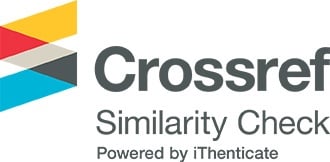Antiglycemic and antihypertension potential of extract from Syzygium malaccense (L.) Merr. & L.M.Perry leaf
Các tác giả
DOI: https://doi.org/10.59294/HIUJS2025025Từ khóa:
Syzygium malaccense, α-glucosidase, α-amylase, angiotensin-converting enzyme (ACE), Dipeptidyl peptidase IV (DPP-IV)Tóm tắt
Background: Diabetes and hypertension are diseases of an increased rate in humans. The target enzymes of two diseases are α-glucosidase, α-amylase, dipeptidyl peptidase-IV (DPP-IV), and angiotensin-converting enzyme (ACE). Objective: The aim of this study is to determine the inhibition ability of inhibition ability α-glucosidase, α-amylase, dipeptidyl peptidase-IV (DPP-IV), and angiotensin-converting enzyme (ACE) of extract from S. malaccense leaves. Materials and method: S. malaccense leaves were extracted with 96% alcohol at a ratio of 1:25 (w/v) to obtain total extract (TP). A quantity of total extract was fractionated with ethyl ether, ethyl acetate, and n-butanol solvents to obtain ethyl ether extract (EE extract), ethyl acetate extract (EA extract), n-butanol (BU extract), and the remaining aqueous solution (WA extract). TP extract and fractionated extracts were determined for enzyme inhibitory activity. Results: BU extract has the most potent inhibitory activity on α-amylase enzymes with an IC50 value of 265.23 µg/mL. The ethyl acetate (EA) extract was found with the highest inhibitory activity on α-glucosidase, DPP-IV, and ACE activity at IC50 values of 107.34 µg/mL, 160.07 µg/mL, and 186.32 µg/mL, respectively. Conclusion: The research indicates that leaf extracts can be applied to support the treatment of hypertension and diabetes.
Abstract
Background: Diabetes and hypertension are diseases of an increased rate in humans. The target enzymes of two diseases are α-glucosidase, α-amylase, dipeptidyl peptidase-IV (DPP-IV), and angiotensin-converting enzyme (ACE). Objective: The aim of this study is to determine the inhibition ability of inhibition ability α-glucosidase, α-amylase, dipeptidyl peptidase-IV (DPP-IV), and angiotensin-converting enzyme (ACE) of extract from S. malaccense leaves. Materials and method: S. malaccense leaves were extracted with 96% alcohol at a ratio of 1:25 (w/v) to obtain total extract (TP). A quantity of total extract was fractionated with ethyl ether, ethyl acetate, and n-butanol solvents to obtain ethyl ether extract (EE extract), ethyl acetate extract (EA extract), n-butanol (BU extract), and the remaining aqueous solution (WA extract). TP extract and fractionated extracts were determined for enzyme inhibitory activity. Results: BU extract has the most potent inhibitory activity on α-amylase enzymes with an IC50 value of 265.23 µg/mL. The ethyl acetate (EA) extract was found with the highest inhibitory activity on α-glucosidase, DPP-IV, and ACE activity at IC50 values of 107.34 µg/mL, 160.07 µg/mL, and 186.32 µg/mL, respectively. Conclusion: The research indicates that leaf extracts can be applied to support the treatment of hypertension and diabetes.
Tài liệu tham khảo
[1] E. P. Setyaningsih, F. C. Saputri, and A. Mun'im, 'The antidiabetic effectivity of Indonesian plants extracts via DPP-IV inhibitory mechanism', Journal of Young Pharmacists, vol. 11, no. 2, p. 161, 2019.
DOI: https://doi.org/10.5530/jyp.2019.11.34[2] B. Baraik, P. Jain, and H. P. Sharma, 'Achyranthes aspera L.: As a Source of Bio-fungicide', Am J Adv Drug Deliv, vol. 2, no. 6, pp. 686-696, 2014.
[3] H. Smulyan, A. Lieber, and M. E. Safar, 'Hypertension, diabetes type II, and their association: role of arterial stiffness', Am J Hypertens, vol. 29, no. 1, pp. 5-13, 2016.
DOI: https://doi.org/10.1093/ajh/hpv107[4] J. L. Izzo Jr and M. R. Weir, 'Angiotensin‐converting enzyme inhibitors', The Journal of Clinical Hypertension, vol. 13, no. 9, p. 667, 2011.
DOI: https://doi.org/10.1111/j.1751-7176.2011.00508.x[5] D. A. Sica, 'Angiotensin‐Converting Enzyme Inhibitors' Side Effects—Physiologic and Non‐Physiologic Considerations', The Journal of Clinical Hypertension, vol. 7, pp. 17-23, 2005.
DOI: https://doi.org/10.1111/j.1524-6175.2005.04556.x[6] N. Chaudhary, L. Sabikhi, S. A. Hussain, and S. K. MH, 'A comparative study of the antioxidant and ACE inhibitory activities of selected herbal extracts', J Herb Med, vol. 22, p. 100343, 2020.
DOI: https://doi.org/10.1016/j.hermed.2020.100343[7] Â. G. Batista et al., 'Red-jambo (Syzygium malaccense): Bioactive compounds in fruits and leaves', LWT-Food science and technology, vol. 76, pp. 284-291, 2017.
DOI: https://doi.org/10.1016/j.lwt.2016.05.013[8] B. Arumugam, T. Manaharan, C. K. Heng, U. R. Kuppusamy, and U. D. Palanisamy, 'Antioxidant and antiglycemic potentials of a standardized extract of Syzygium malaccense', LWT-Food science and technology, vol. 59, no. 2, pp. 707-712, 2014.
[9] A. B. M. N. Uddin, F. Hossain, A. S. M. A. Reza, M. S. Nasrin, and A. H. M. K. Alam, 'Traditional uses, pharmacological activities, and phytochemical constituents of the genus Syzygium: A review', Food Sci Nutr, vol. 10, no. 6, pp. 1789-1819, 2022.
[10] K. Li et al., 'Inhibitory effects against α-glucosidase and α-amylase of the flavonoids-rich extract from Scutellaria baicalensis shoots and interpretation of structure-activity relationship of its eight flavonoids by a refined assign-score method', Chem Cent J, vol. 12, pp. 1-11, 2018.
DOI: https://doi.org/10.1186/s13065-018-0445-y[11] T. H. N. The Han Nguyen et al., 'Antidiabetic and antioxidant activities of red seaweed Laurencia dendroidea.', Asian Pac J Trop Biomed, vol. 9, no. 12, pp. 501-509, 2019.
[12] I. M. E. Lacroix and E. C. Y. Li-Chan, 'Inhibition of dipeptidyl peptidase (DPP)-IV and α-glucosidase activities by pepsin-treated whey proteins', J Agric Food Chem, vol. 61, no. 31, pp. 7500-7506, 2013.
[13] D.-H. Ngo, B. Ryu, and S.-K. Kim, 'Active peptides from skate (Okamejei kenojei) skin gelatin diminish angiotensin-I converting enzyme activity and intracellular free radical-mediated oxidation', Food Chem, vol. 143, pp. 246-255, 2014.
DOI: https://doi.org/10.1016/j.foodchem.2013.07.067[14] K. Tadera, Y. Minami, K. Takamatsu, and T. Matsuoka, 'Inhibition of α-glucosidase and α-amylase by flavonoids', J Nutr Sci Vitaminol (Tokyo), vol. 52, no. 2, pp. 149-153, 2006.
DOI: https://doi.org/10.3177/jnsv.52.149[15] H. P. Syama et al., 'Syzygium cumini seed exhibits antidiabetic potential via multiple pathways involving inhibition of α‐glucosidase, DPP‐IV, glycation, and ameliorating glucose uptake in L6 cell lines', J Food Process Preserv, vol. 42, no. 2, p. e13464, 2018.
DOI: https://doi.org/10.1111/jfpp.13464Tải xuống
Tải xuống: 95











